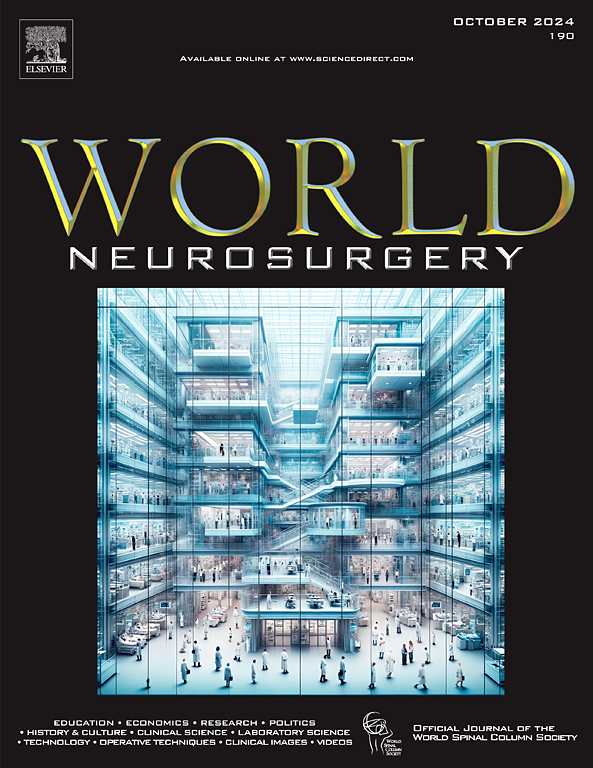间充质干细胞和许旺细胞联合细胞疗法改善脊髓损伤患者的神经源性膀胱功能障碍:一项随机、开放标签的II期临床试验。
IF 1.9
4区 医学
Q3 CLINICAL NEUROLOGY
引用次数: 0
摘要
目的首次研究鞘内联合应用自体骨髓间充质干细胞(BMSCs)和许旺细胞(SCs)对完全性SCI患者泌尿功能改善的疗效:本研究是一项随机II期临床试验,包括治疗组和对照组。方法:该研究是一项随机II期临床试验,包括治疗组和对照组,纳入了外伤性完全性SCI引起的神经源性膀胱(NGB)患者。治疗组接受一次鞘内注射自体BMSCs和SCs的联合治疗。对照组不进行额外干预。研究结果的衡量指标包括尿动力学研究(UDS)参数、尿失禁和尿路感染(UTI)发作次数、尿失禁生活质量(I-QOL)问卷、功能状态和感觉运动改善情况:在招募的 32 名患者中,治疗组和对照组分别有 13 人和 16 人接受了完整的随访。6 个月后,两组患者的膀胱顺应性(p=0.032)、Pdetmax(p=0.013)、PdetQmax(p=0.020)、Qmax(p=0.001)和 PVR(p=0.001)的变化有显著差异。治疗组的尿失禁发作次数(p=0.022)在 6 个月后与基线相比明显减少。与对照组相比,治疗组的 I-QOL 总分和领域得分在 6 个月后有明显改善:结论:BMSCs和SCs联合鞘内注射能明显改善完全性SCI诱导的NGB患者的UDS参数、尿失禁率和尿失禁生活质量。本文章由计算机程序翻译,如有差异,请以英文原文为准。
Improvement of Neurogenic Bladder Dysfunction Following Combined Cell Therapy with Mesenchymal Stem Cell and Schwann Cell in Spinal Cord Injury: A Randomized, Open-Label, Phase II Clinical Trial
Objective
To investigate the efficacy of intrathecal combined administration of autologous bone marrow-derived mesenchymal stem cells (BMSCs) and Schwann cells (SCs) in urinary function improvement in complete spinal cord injury (SCI) patients for the first time.
Methods
This study was a randomized phase II clinical trial, including treatment and control arms. Patients with traumatic complete SCI-induced neurogenic bladder were included. The treatment group received a single intrathecal combined injection of autologous BMSCs and SCs. The control group underwent no additional intervention. The outcome measures of the study were urodynamic study parameters, number of incontinence and urinary tract infection episodes, incontinence quality of life questionnaire, functional status, and sensorimotor improvements.
Results
Among a total of 32 recruited patients, 13 and 16 were completely followed up in the treatment and control group, respectively. Changes in bladder compliance (P = 0.032), maximum pressure of detrusor during the filling phase (P = 0.013), maximum pressure of detrusor at the maximum urinary flow rate (P = 0.020), maximum urinary flow rate (P = 0.001), and postvoid residual volume (P = 0.001) after 6 months were significantly different between the 2 groups. The number of urinary incontinence episodes (P = 0.022) significantly reduced in the treatment group after 6 months compared with the baseline. The incontinence quality of life total and domain scores significantly improved in the treatment group compared with the control group after 6 months.
Conclusions
The combined intrathecal administration of BMSCs and SCs significantly improved the urodynamic study parameters, urinary incontinence rate, and incontinence quality of life in complete SCI-induced neurogenic bladder.
求助全文
通过发布文献求助,成功后即可免费获取论文全文。
去求助
来源期刊

World neurosurgery
CLINICAL NEUROLOGY-SURGERY
CiteScore
3.90
自引率
15.00%
发文量
1765
审稿时长
47 days
期刊介绍:
World Neurosurgery has an open access mirror journal World Neurosurgery: X, sharing the same aims and scope, editorial team, submission system and rigorous peer review.
The journal''s mission is to:
-To provide a first-class international forum and a 2-way conduit for dialogue that is relevant to neurosurgeons and providers who care for neurosurgery patients. The categories of the exchanged information include clinical and basic science, as well as global information that provide social, political, educational, economic, cultural or societal insights and knowledge that are of significance and relevance to worldwide neurosurgery patient care.
-To act as a primary intellectual catalyst for the stimulation of creativity, the creation of new knowledge, and the enhancement of quality neurosurgical care worldwide.
-To provide a forum for communication that enriches the lives of all neurosurgeons and their colleagues; and, in so doing, enriches the lives of their patients.
Topics to be addressed in World Neurosurgery include: EDUCATION, ECONOMICS, RESEARCH, POLITICS, HISTORY, CULTURE, CLINICAL SCIENCE, LABORATORY SCIENCE, TECHNOLOGY, OPERATIVE TECHNIQUES, CLINICAL IMAGES, VIDEOS
 求助内容:
求助内容: 应助结果提醒方式:
应助结果提醒方式:


